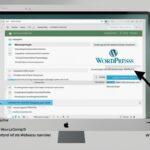Table of Contents
Determining whether a website is built using WordPress can be helpful for those who work with the platform. There are several ways to identify WordPress websites.
One way is to look for the “Powered by WordPress” credits in the footer of the website. However, these credits can be removed by website owners.
Another method is to check the source code of the website and search for keywords such as “WordPress” or “wp-content”. Additionally, adding “/wp-admin” to the end of the homepage URL can reveal if the website is using WordPress.
There are also online tools and browser extensions available that can provide immediate answers. BuiltWith and Is it WordPress? are two popular online tools that can determine if a website is built with WordPress. Chrome Sniffer and BuiltWith Add-on are browser extensions that can quickly identify WordPress websites.
These methods can help speed up the process of identifying whether a website is built using WordPress or not.
The presence of WordPress credits in the footer of a website is a common indicator that it is built using WordPress. This can be seen as a way for website owners to give credit to the platform that powers their site.
However, it’s important to note that these credits can be removed by the website owner, so their absence doesn’t necessarily mean that the website is not built with WordPress. Many website owners choose to remove the default WordPress credits and replace them with their own branding or footer information.
“The presence of WordPress credits in the footer of a website is a common indicator that it is built using WordPress.”
Removing WordPress credits from the footer can be done through customizations or modifications made to the theme or template used for the website. This could involve editing the footer.php file or using a WordPress plugin specifically designed to remove or replace the credits.
In some cases, website owners may want to hide the fact that their website is built using WordPress, perhaps to create a more customized or unique brand image. By removing the WordPress credits, they can make it less obvious to visitors that their site is built on the WordPress platform.
Overall, while the presence of WordPress credits in the footer can be a strong indication that a website is built using WordPress, it is not an absolute guarantee. Website owners have the flexibility to remove or replace these credits to suit their own preferences and branding.
Search for ‘WordPress’ or ‘Wp-Content’ in The Source
Determining whether a website is built using WordPress can be a crucial step in understanding its structure and functionality. One effective method to identify WordPress websites is by inspecting the source code. By right-clicking on the website and selecting “view source,” you can gain access to the underlying code.
Once you have the source code in front of you, it’s time to search for keywords that indicate the usage of WordPress. Two commonly used keywords are “WordPress” and “wp-content.” The presence of these keywords suggests that the website is built using WordPress as its content management system.
Using the “Ctrl + F” shortcut or the search function in your preferred code editor, search for “WordPress” within the source code. This will help you identify any instances where the keyword appears, providing a strong indication of WordPress usage.
Another keyword to search for is “wp-content.” The “wp-content” folder is a crucial component of a WordPress website as it contains all the media files used to visualize the website’s content, including images, videos, and audio files. If the source code contains references or paths to the “wp-content” folder, it further confirms the WordPress CMS usage.
Remember, finding these keywords in the source code is not definitive proof that a website is built using WordPress. It’s possible for website owners to modify their source code or use certain techniques to hide these keywords. However, in most cases, their presence indicates a WordPress-based website.
Knowing how to search for “WordPress” and “wp-content” keywords in a website’s source code can provide valuable insights into its CMS usage. This technique is particularly useful when other identification methods, such as checking the website’s footer or adding “/wp-admin” to the URL, are inconclusive.
To illustrate this process, consider the following snippet of source code:
<html>
<head>
<title>My Website</title>
</head>
<body>
<div class="container">
<h1>Welcome to My Website!</h1>
</div>
<!-- PHP code for WordPress theme customization -->
<?php
// Custom PHP code
?>
<img src="https://example.com/wp-content/uploads/image.jpg" alt="Image">
</body>
</html>
In this example, we can see that the source code contains both “WordPress” and “wp-content” keywords. The presence of these keywords, along with the reference to the “wp-content/uploads” folder, strongly suggests that this website is built using WordPress.
Benefits of Identifying WordPress Keywords in the Source Code
Identifying WordPress keywords in the source code can provide several advantages:
- Confirmation of WordPress Usage: When the keywords “WordPress” and “wp-content” appear in the source code, it serves as a strong confirmation that the website is built using WordPress. This knowledge can be useful for developers, designers, and individuals working with WordPress.
- Insight into Customizations: By analyzing the source code, you can gain insights into any customizations made to the WordPress theme or other aspects of the website. This information can be valuable when troubleshooting issues or making modifications.
- Understanding the File Structure: The presence of “wp-content” keywords reveals the location of the media files used on the website. This knowledge can be beneficial for managing and organizing the media assets within the WordPress CMS.
Overall, searching for “WordPress” and “wp-content” keywords in the source code provides a reliable method to determine if a website is built using WordPress. While it may not be foolproof, it can significantly contribute to identifying the CMS being used.

Add ‘Wp-Admin’ at The End of The Homepage
One simple method to determine if a website is built using WordPress is by adding “/wp-admin” at the end of the homepage URL. This action takes you directly to the login page of the WordPress backend, where the website administrators or contributors can access the site’s dashboard. The WordPress backend is a standard feature that allows users to make various modifications to the website, such as adjusting the layout, publishing posts, or changing settings.
If the URL redirects to a page that resembles the WordPress backend login screen, it confirms that the website is indeed built using WordPress. This method offers a quick and reliable way to determine the content management system (CMS) of a website.
Accessing the WordPress backend through the “/wp-admin” URL can be especially useful for those working with WordPress or needing to identify the CMS of a particular website. It provides direct access to the backend, allowing for efficient management and customization.
Note: The image above illustrates the login page of the WordPress backend, accessed by adding “/wp-admin” to the homepage URL.
Online Tools and Browser Extensions
Identifying if a website is built using WordPress can be made easier with the help of online tools and browser extensions. These tools and extensions provide a convenient and efficient way to determine the content management system (CMS) utilized by a website.
One popular online tool for identifying CMS is BuiltWith. It offers comprehensive information about a website, including its CMS. With BuiltWith, users can determine if a website is built using WordPress and even obtain specific details about the WordPress version being used.
Another online tool called Is it WordPress? provides a straightforward answer by simply confirming whether a website is built with WordPress or not. This tool eliminates the need for manual inspection or analysis.
In addition to online tools, there are also browser extensions available for quick WordPress recognition. Extensions like Chrome Sniffer and BuiltWith Add-on display the logo or information about the software used on a website, allowing users to identify if WordPress is being used as the CMS.
FAQ
How can I tell if a website is built using WordPress?
There are a few different ways to determine if a website is built using WordPress. One method is to look for the presence of “Powered by WordPress” credits in the footer of the website. However, it’s important to note that these credits can be removed by the website owner. Another way is to check the source code of the website and search for keywords such as “WordPress” or “wp-content”. Additionally, adding “/wp-admin” to the end of the homepage URL can reveal if the website is using WordPress. There are also online tools and browser extensions available that can provide immediate answers.
Look for the “Powered by WordPress” credits in the footer of the website. This is a common indicator that the website is built using WordPress. However, it’s important to note that website owners can choose to remove these credits, so their absence does not necessarily mean that the website is not built with WordPress.
How can I check the source code of a website to see if it’s using WordPress?
To check the source code of a website, right-click on the website and select “view source”. Then, search for keywords such as “WordPress” or “wp-content” in the source code. If these keywords are present, it suggests that the website is built using WordPress as the content management system. The “wp-content” folder is a significant part of a WordPress website as it contains the media files used to visualize the website’s content.
How do I determine if a website is using WordPress by adding ‘/wp-admin’ to the URL?
Simply add “/wp-admin” to the end of the homepage URL. If the URL redirects to a page that resembles the WordPress backend login screen, it indicates that the website is built using WordPress. The WordPress backend login screen is where website administrators or contributors make modifications to the website’s layout, publish posts, and adjust settings.
Are there any online tools or browser extensions that can help identify if a website is built using WordPress?
Yes, there are several online tools and browser extensions available for this purpose. BuiltWith and Is it WordPress? are two popular online tools that can determine if a website is built with WordPress. They can provide detailed information about the website, including the specific version of WordPress being used. Chrome Sniffer and BuiltWith Add-on are browser extensions that can quickly identify WordPress websites by displaying the logo or information about the software being used on the website.







